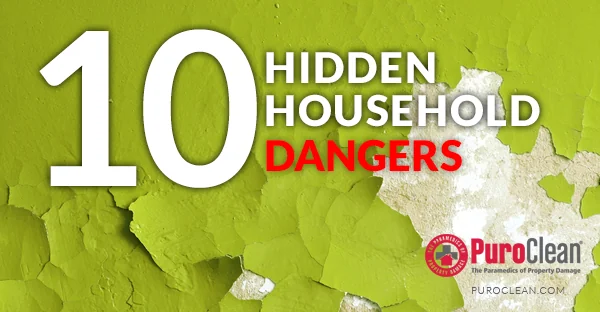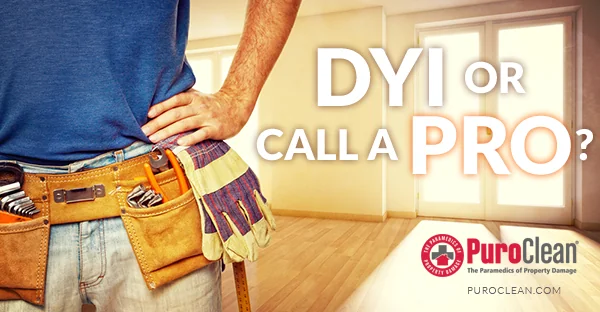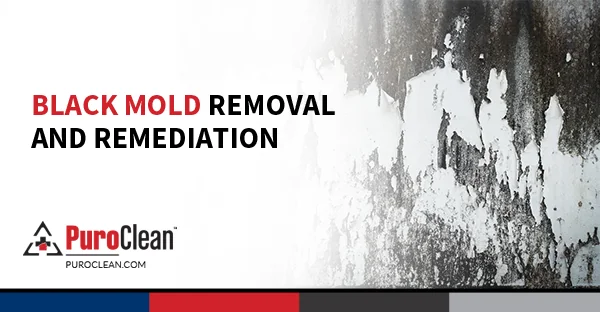
Table of Contents
Your home should be your sanctuary a place where you and your family feel safe, comfortable, and protected from the outside world.
However, many homeowners are unaware that their living spaces may harbor invisible dangers that can significantly impact their health and wellbeing over time. These hidden household hazards often go unnoticed for years, silently affecting the air we breathe, the water we drink, and the surfaces we touch daily.
At PuroClean, we understand that knowledge is power when it comes to protecting your family. That’s why we’ve compiled this comprehensive guide to help you identify, understand, and eliminate the most common hidden dangers lurking in homes across America. From toxic gases to harmful chemicals, these threats require immediate attention and professional intervention to ensure your family’s safety.
1. Lead: The Silent Threat in Older Homes
Lead poisoning remains one of the most serious environmental health hazards, particularly for children under six years old. This toxic metal can cause irreversible damage to the nervous system, leading to learning disabilities, behavioral problems, and developmental delays. Adults exposed to lead may experience high blood pressure, kidney problems, and reproductive issues.
Where Lead Hides:
- Paint in homes built before 1978
- Soil contaminated by decades of leaded gasoline and paint chips
- Dust particles from deteriorating lead-based surfaces
- Water pipes and plumbing fixtures in older homes
- Imported toys, jewelry, and pottery
- Some cosmetics and traditional medicines
Prevention Strategies: Have your entire family tested for lead levels, especially if you live in a home built before 1978. If lead is detected, hire only EPA-certified contractors for removal never attempt DIY lead paint removal, as improper handling can increase exposure. Regular cleaning with damp cloths and mopping can help reduce lead dust accumulation.
2. Mold: The Hidden Health Destroyer
Mold growth in homes is more common than most people realize, thriving in environments with moisture levels above 60%. Beyond the musty odor and unsightly appearance, mold exposure can trigger serious respiratory problems, allergic reactions, and even neurological symptoms in sensitive individuals.
Common Mold Locations:
- Bathrooms, especially around tubs and showers
- Basements and crawl spaces
- Around windows and doors
- HVAC systems and ductwork
- Behind wallpaper and under carpets
- Areas affected by water damage
Professional Remediation: Mold remediation requires specialized equipment and expertise. Professional mold removal companies use containment barriers, HEPA filtration systems, and antimicrobial treatments to safely eliminate mold colonies and prevent recurrence. Never ignore mold growth—early intervention is crucial for protecting your family’s health and your property’s value.
3. Carbon Monoxide: The Invisible Killer
Carbon monoxide (CO) poisoning sends over 20,000 Americans to emergency rooms annually, earning it the nickname “the silent killer.” This odorless, colorless gas is produced whenever organic fuel burns incompletely, making it a serious threat in homes with gas appliances, fireplaces, or attached garages.
CO Sources in Your Home:
- Malfunctioning furnaces and water heaters
- Blocked chimneys and flues
- Gas stoves and ovens
- Portable generators (never use indoors)
- Car engines running in attached garages
- Charcoal grills used indoors
Critical Safety Measures: Install CO detectors on every level of your home, especially near sleeping areas. Schedule annual professional inspections of all fuel-burning appliances and ensure proper ventilation for all heating systems. Never use portable generators, grills, or camp stoves inside your home, garage, or near windows.
4. Pesticides: Toxic Protection with Dangerous Consequences
While pesticides effectively control unwanted pests, they contain powerful toxins that pose significant health risks, particularly to children and pets. These chemicals can cause acute poisoning symptoms and long-term health problems including cancer, neurological disorders, and reproductive issues.
Safe Pesticide Practices: Store all pesticides in locked cabinets, away from children and pets. Always read and follow label instructions exactly—more is not better when it comes to pesticide application. Consider integrated pest management (IPM) strategies that minimize chemical use while effectively controlling pests through prevention and targeted treatments.
5. Foodborne Pathogens: Kitchen Contamination Risks
Salmonella and E. coli bacteria cause millions of foodborne illnesses annually, with symptoms ranging from mild stomach upset to life-threatening complications. These pathogens thrive in warm, moist environments and can multiply rapidly on contaminated surfaces.
Food Safety Fundamentals: Maintain separate cutting boards for raw meat and vegetables. Cook all meats to safe internal temperatures (165°F for poultry, 160°F for ground meat, 145°F for whole cuts). Wash hands thoroughly after handling raw meat and sanitize all surfaces that come into contact with raw foods. Refrigerate perishable foods within two hours of preparation.
6. Air Fresheners: Chemical Cocktails in Disguise
Commercial air fresheners may make your home smell pleasant, but they often contain phthalates and volatile organic compounds (VOCs) that can trigger asthma, allergies, and other respiratory problems. These chemicals can also disrupt endocrine function and contribute to indoor air pollution.
Healthier Alternatives: Replace chemical air fresheners with natural alternatives like essential oil diffusers, activated charcoal, or houseplants that naturally purify air. Address odor sources directly rather than masking them with fragrances. Consider whole-house air purification systems with HEPA filtration for comprehensive air quality improvement.
7. Radon: The Radioactive Basement Threat
Radon gas, the second leading cause of lung cancer in the United States, seeps into homes through foundation cracks, gaps around pipes, and other openings. This radioactive gas is particularly dangerous because it’s completely undetectable without specialized testing equipment.
Radon Testing and Mitigation: Test your home for radon using EPA-approved test kits or hire a certified radon professional. If levels exceed 4 picocuries per liter, install a radon mitigation system. These systems typically include sub-slab depressurization, which prevents radon from entering your home by creating negative pressure beneath the foundation.
8. Aerosol Sprays: Airborne Chemical Exposure
Aerosol sprays release fine particles and volatile chemicals that can trigger asthma attacks, respiratory irritation, and allergic reactions. The pressurized delivery system creates an inhalable mist that can penetrate deep into the lungs.
Safer Application Methods: Choose pump-spray alternatives whenever possible and always use aerosols in well-ventilated areas. Wear protective equipment when using cleaning or pesticide sprays and never spray aerosols near children or pets. Store aerosol cans properly to prevent accidental discharge.
9. Plastic Products: Hidden Chemical Exposure
Many plastic products contain harmful chemicals like BPA, phthalates, and PVC that can leach into food and drinks, particularly when heated. These endocrine disruptors can affect hormone function and development, especially in children.
Safer Plastic Choices: Look for recycling codes 1, 2, 4, and 5 when purchasing plastic products these are generally safer options. Avoid heating food in plastic containers and replace old or damaged plastic items regularly. Consider glass or stainless-steel alternatives for food storage and drinking containers.
10. Tap Water: The Contaminated Convenience
Municipal water treatment doesn’t eliminate all contaminants, and well water may contain naturally occurring toxins or pollutants from nearby sources. Common contaminants include chlorine, lead, pesticides, bacteria, and industrial chemicals.
Water Quality Solutions: Install a comprehensive water filtration system appropriate for your specific contamination concerns. Have your water tested annually, especially if you have a private well. Consider point-of-use filters for drinking water and whole-house systems for complete protection.
Taking Action: Your Family’s Safety Starts Today
Awareness of these hidden household dangers is only the first step toward creating a safer home environment. At PuroClean, we’re committed to helping families identify and eliminate these invisible threats through professional assessment, remediation, and ongoing prevention strategies.
Don’t wait until health problems arise take proactive steps to protect your family today. Contact PuroClean to schedule a comprehensive home safety assessment and develop a customized plan to address the specific risks in your living environment. Your family’s health and safety are worth the investment in professional protection and peace of mind.
Remember, creating a truly safe home requires vigilance, knowledge, and sometimes professional intervention. By understanding these hidden dangers and taking appropriate action, you can transform your home into the safe haven it should be for you and your loved ones.
- property to its pre-damage condition.
Protect Your Investment & Restore Your Peace of Mind
Don’t let water damage and potential mold growth overwhelm you. Contact PuroClean of Lansdale today at (267) 834-5900 for a free consultation. We’ll be there to guide you through the restoration process and ensure your property is restored quickly, safely, and efficiently.




 PuroClean of Lansdale
PuroClean of Lansdale